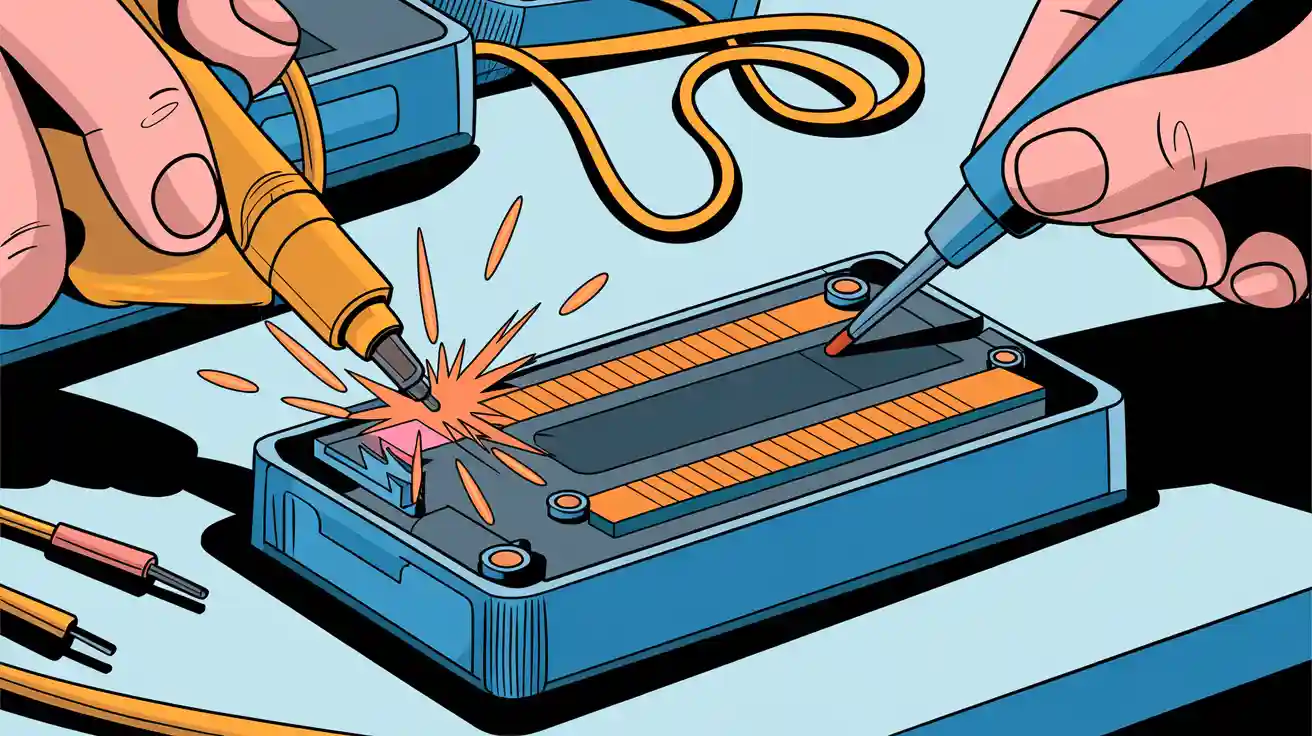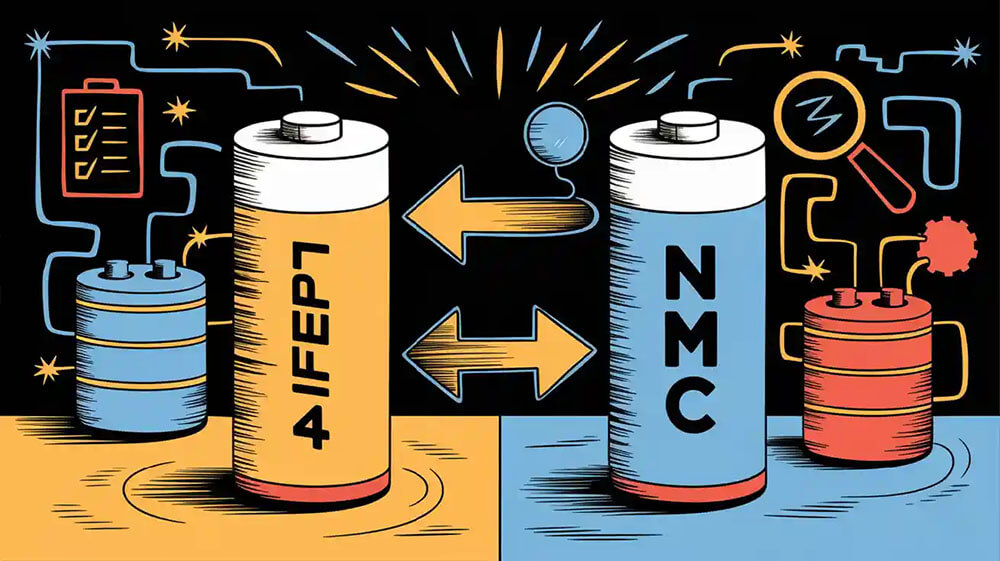Contents

Spot welding and soldering are essential techniques in lithium battery assembly, and understanding the difference between spot welding and soldering lithium batteries is crucial. Spot welding, widely used due to its speed and reliability, ensures strong connections between battery cells. On the other hand, soldering, preferred for smaller components, demands precision and careful material selection. Choosing the right method affects your battery’s performance, durability, and long-term reliability.
Key Takeaways
Spot welding works quickly, handling up to 4500 pieces an hour. This makes it great for building many batteries at once.
Soldering creates exact connections, perfect for small projects or parts. It needs careful heat control to prevent harm.
Picking spot welding or soldering depends on your project. Spot welding is strong and long-lasting, while soldering is flexible and easy to fix.
Part 1: Spot Welding for Lithium Batteries
1.1 Definition and Process
Spot welding is a critical technique in lithium battery manufacturing, particularly for connecting battery tabs. The process involves delivering a high current over a short duration to create a resistance weld. This ensures a secure connection between components without damaging sensitive materials. Specialized machines, such as battery spot welders, are designed to streamline this procedure, offering precision and efficiency. Common methods include ultrasonic welding, laser welding, and resistance welding. Setting up the spot welder correctly is essential to manage heat and pressure effectively, ensuring consistent welds across the battery pack.
1.2 Applications in Battery Assembly
Spot welding lithium cells plays a vital role in assembling battery packs for consumer electronics, electric vehicles, and industrial applications. It is particularly useful for creating strong, reliable joints in compact devices where space is limited. The method is also employed in robotics and medical battery systems, where safety and precision are paramount. As devices become smaller and more complex, spot welding ensures durability without compromising sensitive components.
1.3 Advantages of Spot Welding
Spot welding offers several benefits that make it a preferred choice in lithium battery assembly:
Efficiency: The battery spot welding process can handle 4000-4500 pieces per hour, with each weld taking only 0.8-1 second.
Consistency: Performing the spot welds ensures uniformity, reducing false welds and enhancing battery pack quality.
Automation: Advanced machines provide automatic feedback compensation, minimizing errors and manual intervention.
Versatility: Machines can store up to 99 groups of welding parameters, accommodating various lithium cell types.
Advantage | Description |
|---|---|
Efficiency | Spot welding speed of 0.8-1 second per piece, processing 4000-4500 pieces per hour. |
Consistency | Ensures welding consistency, reducing false welding and improving battery pack quality. |
Automation | Automatic feedback compensation reduces manual intervention, leading to fewer errors. |
Versatility | Can store up to 99 groups of welding parameters for different cell types. |
1.4 Limitations of Spot Welding
Despite its advantages, spot welding has limitations that you must consider:
Abnormal weld spots may compromise safety, as evidenced by incidents like the Samsung Note 7.
Fast charging at low temperatures increases the risk of dendrite formation, which can damage lithium cells.
Inspecting the welds regularly and managing heat and pressure during the battery spot welding procedure can mitigate these risks.
For customized solutions tailored to your battery assembly needs, explore Large Power’s custom battery solutions.
Part 2: Soldering for Lithium Batteries
2.1 Definition and Process
Soldering is a technique used to join metal components by melting a filler material, known as solder, to create a conductive bond. In lithium battery assembly, soldering lithium cells involves connecting battery terminals or tabs to circuit boards or other components. The process requires precise temperature control to avoid damaging the battery’s sensitive materials. Common soldering methods include wave soldering, manual soldering, and reflow soldering.
The CQI-17 Special Process document provides guidelines for soldering system assessments, emphasizing defect prevention and process control. These principles are critical for ensuring the reliability of soldered connections in lithium battery manufacturing.
Document Title | Purpose | Relevance to Battery Manufacturing |
|---|---|---|
CQI-17 Special Process: Electronic Assembly Manufacturing – Soldering System Assessment | Development of a soldering management system for continual improvement and defect prevention | Emphasizes process control and proactive defect prevention applicable to battery manufacturing |
2.2 Applications in Battery Assembly
Soldering is widely used in lithium battery assembly for connecting smaller components, such as battery management systems (BMS) and circuit boards. It is particularly suitable for applications requiring precision, such as medical devices, robotics, and consumer electronics. Soldering lithium cells is also favored in DIY projects due to its accessibility and simplicity. However, excessive heat during soldering can weaken battery seals, making it less ideal for high-performance industrial applications.
Method | Pros | Cons |
|---|---|---|
Spot Welding | Fast, strong, low resistance | Requires specialized equipment |
Soldering | Easier for DIY applications | Can weaken battery seals due to excessive heat |
2.3 Advantages of Soldering
Soldering offers several benefits in lithium battery assembly:
Precision: Allows for accurate connections in compact devices.
Accessibility: Suitable for DIY projects and small-scale manufacturing.
Robust Connections: Soldered connections are generally stronger than spot-welded ones.
Electrical Performance: Provides better electrical characteristics compared to spot welding.
💡 Tip: While soldering yields robust connections, ensure proper temperature control to prevent damage to lithium cells.
2.4 Limitations of Soldering
Despite its advantages, soldering has notable drawbacks:
Excessive heat can compromise the reliability of lithium cells.
The process is more complex and requires greater skill compared to spot welding.
Soldering lithium cells can make battery construction more challenging, especially for large-scale production.
Soldering is less suitable for applications demanding high mechanical strength or rapid assembly. For customized solutions tailored to your battery assembly needs, explore Large Power’s custom battery solutions.
Part 3: Comparing Spot Welding vs Soldering
3.1 Conductivity and Electrical Performance
When comparing spot welding vs soldering, conductivity plays a crucial role in determining the electrical connection quality of lithium battery assemblies. Spot welding generally provides superior conductivity due to its ability to create low-resistance joints. The process involves fusing materials directly, minimizing the risk of weak electrical connections. Research shows that optimizing weld patterns, such as using parallel bead segments oriented perpendicular to current flow, can further enhance conductivity by reducing resistance.
In contrast, soldering relies on a filler material to establish connections. While soldered joints can achieve good electrical performance, the additional material introduces higher resistance compared to spot welded connections. This difference becomes significant in high-performance applications, where even minor resistance can impact battery efficiency. For lithium battery packs requiring optimal electrical performance, spot welding often emerges as the preferred method.
3.2 Mechanical Strength and Durability
The mechanical strength of connections directly affects the durability of lithium battery assemblies. Spot welding creates robust, permanent joints capable of withstanding mechanical stress and vibrations. This makes it ideal for applications like electric vehicles and industrial equipment, where batteries face harsh operating conditions. The reliability of a spot welded cell in such environments is unmatched, as the welds maintain their integrity over time.
Soldering, on the other hand, produces connections that are less durable under mechanical stress. The soldered joints are more prone to cracking or breaking, especially in environments with frequent vibrations or temperature fluctuations. While soldering may suffice for smaller, less demanding applications, it falls short in scenarios requiring high mechanical strength.
Aspect | Spot Welding | Soldering |
|---|---|---|
Mechanical Strength | High; withstands stress and vibrations | Moderate; prone to cracking under stress |
Durability | Long-lasting in harsh conditions | Limited in demanding environments |
3.3 Reliability in Long-Term Use
The reliability of a lithium battery depends on the quality and stability of its connections over time. Spot welding excels in this regard, offering consistent performance with minimal degradation. The process minimizes heat exposure, reducing the risk of thermal damage to the battery cells. This ensures that the connections remain stable, even after prolonged use.
Soldering, however, poses challenges in maintaining long-term reliability. The heat required during the process can weaken battery seals, leading to potential leakage or reduced capacity. Additionally, soldered joints are more susceptible to wear and tear, especially in high-temperature or high-vibration environments. For applications demanding long-term reliability, spot welding is often the better choice.
🔧 Pro Tip: Regular inspection of spot welded connections can further enhance the reliability of your lithium battery packs.
3.4 Ease of Construction and Assembly
Spot welding simplifies the construction and assembly of lithium battery packs. The process is faster and easier to automate, making it suitable for large-scale production. Advanced spot welding machines can handle thousands of connections per hour, ensuring efficiency and consistency. This ease of use makes spot welding accessible even to operators with minimal training.
Soldering, in contrast, requires more skill and precision. The process involves multiple steps, including preparing the solder and ensuring proper temperature control. This complexity increases the likelihood of errors, especially in large-scale manufacturing. While soldering may be suitable for small-scale or DIY projects, it is less practical for assembling high-capacity lithium battery packs.
3.5 Repairability and Maintenance
Repairability is another critical factor when comparing spot welding vs soldering. Spot welded connections are challenging to repair due to their permanent nature. However, this permanence also contributes to their reliability, reducing the need for frequent maintenance. In cases where repairs are necessary, specialized tools and expertise are required to remove and replace the welds.
Soldering offers better repairability, as soldered joints can be desoldered and reworked. However, the heat involved in the desoldering process can damage the battery cells, limiting the practicality of repairs. For applications where maintenance and repairability are priorities, soldering may be more suitable, but this comes at the cost of reduced reliability and durability.
💡 Note: Consider your specific application requirements when choosing between spot welding and soldering. For customized solutions, explore Large Power’s custom battery solutions.
Spot welding and soldering offer distinct advantages and limitations in lithium battery assembly. Spot welding excels in speed, durability, and electrical performance, making it ideal for industrial and high-performance applications. Soldering, however, provides precision and repairability, suiting smaller-scale or DIY projects. Choosing the right method depends on your specific application needs.
For businesses, leveraging industry trends can optimize battery production. For example:
Insight | Description |
|---|---|
Leverage IRA incentives | Utilize $369 billion in clean energy incentives to boost local production and diversify supply chains. |
Invest in LFP technology | Focus on cobalt-free LFP batteries to reduce dependency on cobalt. |
Partner with recyclers | Collaborate with recyclers to maximize material recovery and minimize resource reliance. |
Selecting the right method ensures better performance and sustainability. For tailored solutions, consult Large Power’s custom battery solutions.
FAQ
1. Can you spot weld lithium batteries without specialized equipment?
No, you need specialized spot welding machines. These machines ensure precise heat and pressure control, which is critical for safe and reliable connections.
2. Does soldering damage lithium batteries?
Yes, improper soldering can damage lithium batteries. Excessive heat weakens seals and may cause internal damage, reducing the battery’s lifespan and reliability.
3. Which method is better for DIY battery projects?
Soldering is better for DIY projects. It requires less expensive equipment and offers more flexibility for small-scale applications compared to spot welding.
💡 Tip: Always follow safety guidelines when working with lithium batteries to prevent accidents or damage.





